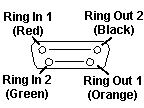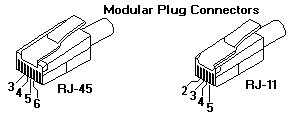|
DE9 Pinout
DE9 Token Ring Wrap Plug
Hacking Cat5 Cable to a DE9 Port
IBM Token-Ring RJ-45 STP Adapter cable
IBM Token-Ring UTP cable
Token Ring - UTP Modular Connector Pinout
IBM RJ-45 STP/D-Shell Conversion Cable
IBM Token Ring Network PC Adapter Cable (STP cable)
IBM Ring In/Ring Out STP Cable
TR Trivia
DE9 Pinout (from Peter)

|
Ring Out 1 (3 RJ) - (9 SUB) - orange
Ring In 1 (5 RJ) - (1 SUB) - red
Ring Out 2 (6 RJ) - (5 SUB) - black
Ring In 2 (4 RJ) - (6 SUB) - green
|
Pins 2,4, 7 and 8 are "DC Common" and Pin 3 is +5VDC on most
adapters. This DC is used for some few MAUs that need additonal power /
adapter present sense signal. Alternatively IBM used "A" instead of "1"
and "B" for "2".
The cable colors refer to the color code IBM used within
the ICS (IBM Cabling System) for all qualified cable types - namely the
cable Type-1.
DE9 Token Ring Wrap Plug IBM 93F1523

|
Pin 1 to Pin 5, dead short
Pin 6 to Pin 9, dead short
|
Hacking Cat5 to a DE9 Port
>> So I guess a DE9 to RJ45 connector with the right wiring and a Cat5
cable will not work?
Peter says:
But ... (there's always a "but", eh ?) ... but if the
length of a single workstation cable does not exceed 15 meters I would
guess it is safe to cut off the one end from a CAT-5 cable and install
a Sub-D 9-pin male plug instead.
The TR topology allowes to have 100 (200) meter cable
length between MAU and station at 16 (4) Mbit/s - and up to 200 (400) meter
between RI/RO of two MAUs.
In this case the cable impedance *is* an important factor
- and to stay on the safe side you should either use IBM Cable type 1 ("the
finger-thick hose") or media filters if you use ICS and CAT-5 cabling in
a combined setup.
For a small "home" network with low average traffic and
with a small physical dimension (say: 8 stations, one single 8228 MAU,
maximum 30 meters end-to-end) you will most likely *never* run into any
problem. But it is unprofessional of course ... ;-)
IBM Token-Ring RJ-45 STP Adapter cable IBM P/N 60G1063

A1 Connector, adapter end 8-position
RJ-45 modular jack
A2 Connector, network end IBM Cabling
System Data Connector
This is used when the adapter has a DE9 port, and the MAU used ICS.
IBM Token-Ring UTP cable Two twisted pairs of UTP cabling.

B1 Connector, adapter end 8-position
RJ-45 modular jack
B2 Connector, network end 8-position
RJ-45 modular jack or 6 position RJ-11 modular jack
Token Ring - UTP Modular Connector

ADAPTER END -- NETWORK END ADAPTER END -- NETWORK END
RJ-45 to RJ-45 RJ-45 to RJ-11
3 ------------- 3 TD- 3 ------------- 2
4 ------------- 4 RD+ 4 ------------- 3
5 ------------- 5 RD- 5 ------------- 4
6 ------------- 6 TD+ 6 ------------- 5
1,2,7,8 1,2,7,8 1,2,7,8 1,6 <- Not used
This cable is used when the adapter is RJ45 (or you use a Media Filter) and
the Media Access Unit (MAU) is UTP also.
IBM RJ-45 STP/D-Shell Conversion Cable IBM P/N 60G1066
Supplied for use with IBM Token-Ring Network PC Adapter cables.

C1 Connector, adapter end 8-position
RJ-45 modular plug
C2 Connector, network end 9-position
D, male
This adapter plugs into the RJ45 port on the adapter and mechanically
changes the cable type to STP for use with the IBM ICS cables.
IBM Token Ring Network PC Adapter Cable (STP cable) IBM P/N 6339098

D1 Connector, adapter end 9-position
D, male
D2 Connector, network end IBM Cabling
System Data Connector or equivalent
These cables are used with adapters that use a DE9 port. For adapters with
RJ45 and DE9 ports, the setup gives you the choice of STP (Shielded Twisted
Pair, which is the IBM ICS cabling) or UTP (Unshielded Twisted Pair, or
Cat3/Cat5 wiring)
IBM Ring In/Ring Out STP Cable

E1 Connector, MAU end IBM Cabling
System Data Connector
E2 Connector, MAU end IBM Cabling
System Data Connector
These are true hermaphrodite cables, used to link 8228 MAUs together
to form a ring. Each ring adds another 8 data ports to the Token Ring network.
I have seen short 1ft, 3ft, and 6ft and longer cables..
TR Trivia
From Peter:
>If I have two MAUs connected RI <-> RO and there are machines
connected to both and then I disconnect the MAUs, can I later reconnect
them and get all the machines to see other again?
No. Normally not. Depends on if you manage to disconnect
the RI/RO cable from both MAUs almost simultaneously before the TR adapter(s)
connected to them get a "Token Lost" time-out and shut down the ring interface.
From the moment you separate the two MAUs one adapter on each becomes "ring
monitor", because you have two separate rings at that time. When you reconnect
the two rings there are *two* tokens and two active ring monitors in one
ring. It takes some time until the negotiation is done which adapter stays
ring monitor (or which *other* adapter takes over) and to re-circulate
the two concurring tokens on the ring.
>I have a server connected to one MAU which can't see any machines connected
to the other. I don't want to reboot this server. How do I get everything
working again properly?
If the server cannot see other machines it is a protocol
error on the server most likely ... so what's the use to kick of the *other*
machines then ? You will need to reboot the server at one point anyway
- so why fussing around with the entire ring.
Question 1: do you see any other station on the entire ring anyway (e.g.
Machine A on MAU-1 sees a Machine B on MAU-2) or isn't there any sort of
communication across the two MAUs at all?
Question 2: which protocol are you using? TCP/IP?
I - for example - have a Linux intranet server, that does not show
up under "Network Neighborhood" - but the shared resources (under SAMBA)
can be used with NET USE X: \\I-SERVER\I-DRIVE from any station in the
network. It is running TCP/IP only, but not IPX/SPX or NETBEUI .... which
are required under Windows to use the "direct name" ("Find Computer")
without having a "hosts" file with the list IP-Address = Name.
|